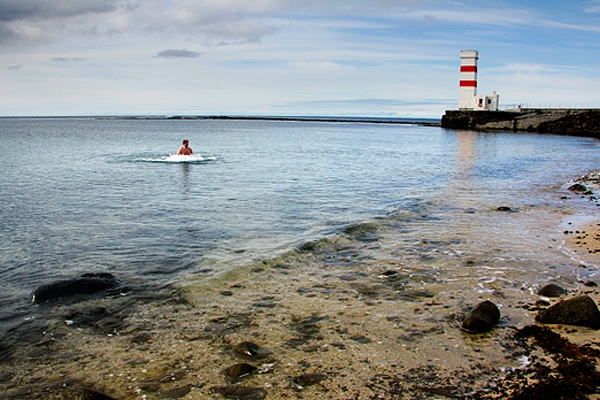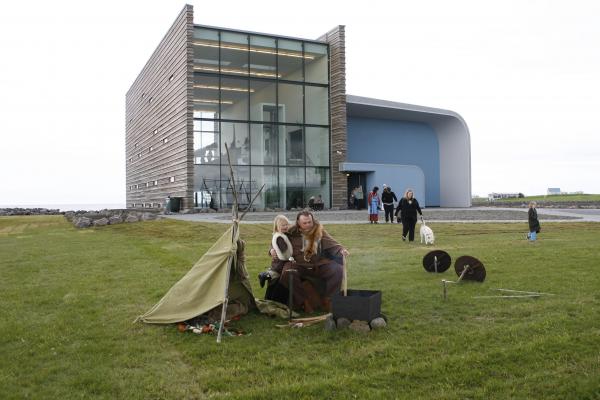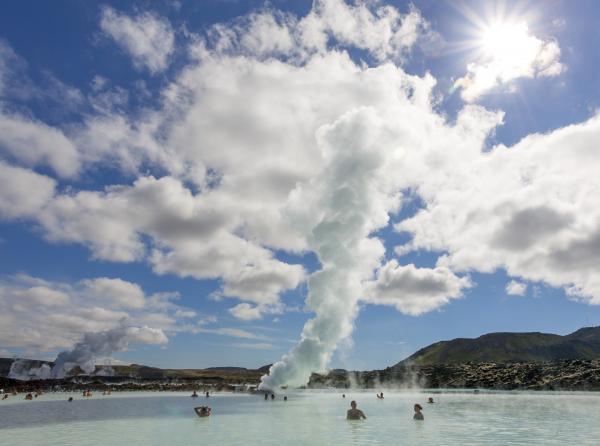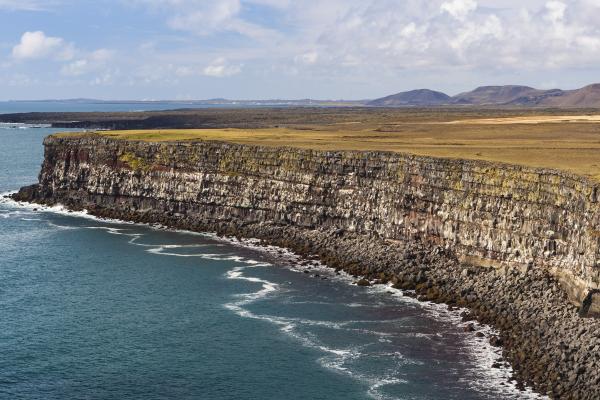For some reason, locals and tourists alike seem to forget all about the wind-swept yet stunning Reykjanes peninsula when travelling around Iceland – and that despite the area being the home to Keflavík airport, and therefore the gateway to Iceland. The area’s most popular destination is without a doubt the lovely Blue Lagoon but there is so much more to see and do.
1. Garðskagi beach

Garðaskagi is a beautiful beach where one can enjoy the most amazing sunsets. There’s also a lovely coffee shop nearby that serves tasty Icelandic waffles topped with whipped cream and homemade jam.
2. Mt Þorbjarnarfell

Þorbjarnarfell, also simply known as Þorbjörn, is a small tuff mountain located near the fishing village of Grindavík. It makes for a relatively easy yet beautiful walk. Once you’re up on the top, you have a fantastic panoramic view over the Reykjanes area.
Only a stone’s throw from Þorbjörn, you’ll find a small forest called Sólbrekkuskógur which, in late summer, early autumn, is full of crowberries.
3. The Viking Museum

Children love to visit the Viking World Museum in Reykjanesbær and Skessuhellir (The Cave of the Giantess). Viking World is a five-exhibition museum located in Reykjanesbær town, along the coast of the Atlantic Ocean. The facility also includes a playground for kids and an outdoor classroom for lectures. The biggest attraction of Vikingworld is the authentic Viking ship built by the Icelandic ship builder Gunnar Marel Eggertsson in 1996.
4. The Blue Lagoon

The Blue Lagoon is one of Iceland's most popular tourist destinations. Steam rises around the facility like a smoke machine out of a movie and the sting of the neon blue water plays tricks with your mind because, at a toasty 38 degrees Celsius, a natural pool is not supposed to be this hot. Located just outside the fishing town of Grindavik, the geothermal power that is exerted around the area has been harboured for the enjoyment of tourists from all over the world.
5. Gunnuhver geothermal area

Gunnuhver's mud pools that stretch over the southwestern part of the Reykjanes peninsula got their name from a female ghost, who fell into the spring over 400 years ago. Today, steam rises up from the natural boiling water in the mud pools, with the largest pool stretching over 20 meters wide inside a rim of mud. Located near the Reykjanes lighthouse, not far from the “Bridge Between Continents,” the Gunnuhver Hot Mud Springs offer a great place to enjoy the scenery of Iceland. From the safety of the bridge’s viewing ramp, you can look down to the spring and hear the bubbling noises of the boiling water.
6. Krísuvíkurbjarg cliffs

One of Iceland’s most stunning bird-watching locations is within one hour of the capital but is often overlooked. The sea cliffs Krýsuvíkurbjarg are a magnificent natural wonder, stretching several kilometers and rising vertically from the sea. During the summer months, the cliffs are packed with up to 60,000 bird couples of nine different species. There is a great hiking trail from the highway, easily navigated in half an hour.
7. Eldvörp craters

Eldvörp is a collection of eighteen volcanic craters that formed during a volcanic eruption in 1224. The area is considered to be a unique geological phenomenon, but for some reason very few people take the time to visit it.
For some reason, locals and tourists alike seem to forget all about the wind-swept yet stunning Reykjanes peninsula when travelling around Iceland – and that despite the area being the home to Keflavík airport, and therefore the gateway to Iceland. The area’s most popular destination is without a doubt the lovely Blue Lagoon but there is so much more to see and do.
1. Garðskagi beach

Garðaskagi is a beautiful beach where one can enjoy the most amazing sunsets. There’s also a lovely coffee shop nearby that serves tasty Icelandic waffles topped with whipped cream and homemade jam.
2. Mt Þorbjarnarfell

Þorbjarnarfell, also simply known as Þorbjörn, is a small tuff mountain located near the fishing village of Grindavík. It makes for a relatively easy yet beautiful walk. Once you’re up on the top, you have a fantastic panoramic view over the Reykjanes area.
Only a stone’s throw from Þorbjörn, you’ll find a small forest called Sólbrekkuskógur which, in late summer, early autumn, is full of crowberries.
3. The Viking Museum

Children love to visit the Viking World Museum in Reykjanesbær and Skessuhellir (The Cave of the Giantess). Viking World is a five-exhibition museum located in Reykjanesbær town, along the coast of the Atlantic Ocean. The facility also includes a playground for kids and an outdoor classroom for lectures. The biggest attraction of Vikingworld is the authentic Viking ship built by the Icelandic ship builder Gunnar Marel Eggertsson in 1996.
4. The Blue Lagoon

The Blue Lagoon is one of Iceland's most popular tourist destinations. Steam rises around the facility like a smoke machine out of a movie and the sting of the neon blue water plays tricks with your mind because, at a toasty 38 degrees Celsius, a natural pool is not supposed to be this hot. Located just outside the fishing town of Grindavik, the geothermal power that is exerted around the area has been harboured for the enjoyment of tourists from all over the world.
5. Gunnuhver geothermal area

Gunnuhver's mud pools that stretch over the southwestern part of the Reykjanes peninsula got their name from a female ghost, who fell into the spring over 400 years ago. Today, steam rises up from the natural boiling water in the mud pools, with the largest pool stretching over 20 meters wide inside a rim of mud. Located near the Reykjanes lighthouse, not far from the “Bridge Between Continents,” the Gunnuhver Hot Mud Springs offer a great place to enjoy the scenery of Iceland. From the safety of the bridge’s viewing ramp, you can look down to the spring and hear the bubbling noises of the boiling water.
6. Krísuvíkurbjarg cliffs

One of Iceland’s most stunning bird-watching locations is within one hour of the capital but is often overlooked. The sea cliffs Krýsuvíkurbjarg are a magnificent natural wonder, stretching several kilometers and rising vertically from the sea. During the summer months, the cliffs are packed with up to 60,000 bird couples of nine different species. There is a great hiking trail from the highway, easily navigated in half an hour.
7. Eldvörp craters

Eldvörp is a collection of eighteen volcanic craters that formed during a volcanic eruption in 1224. The area is considered to be a unique geological phenomenon, but for some reason very few people take the time to visit it.






